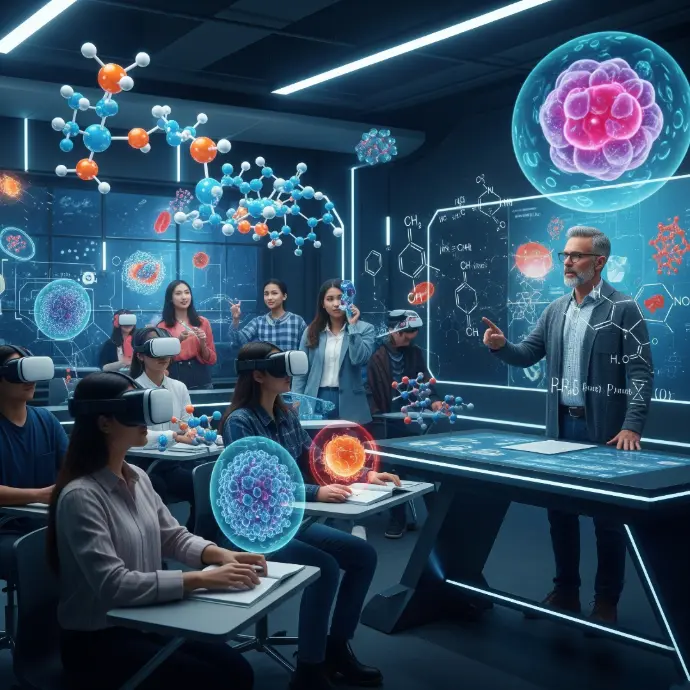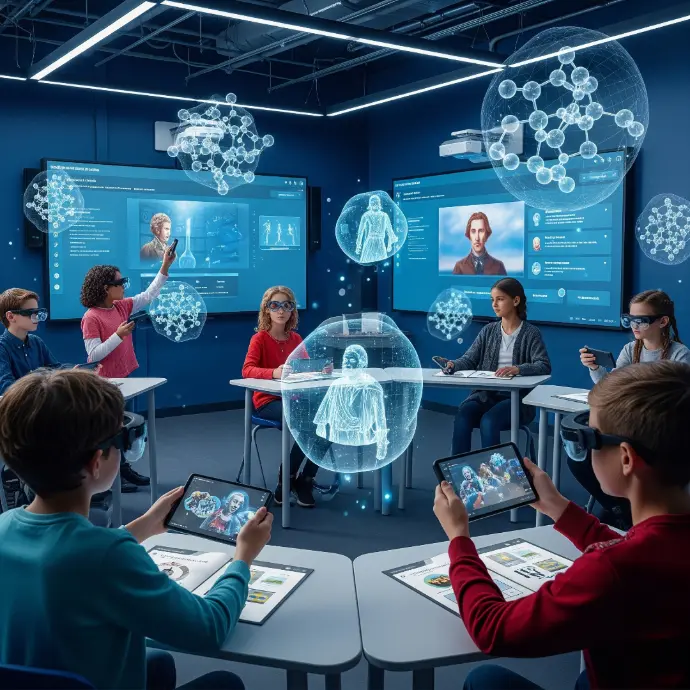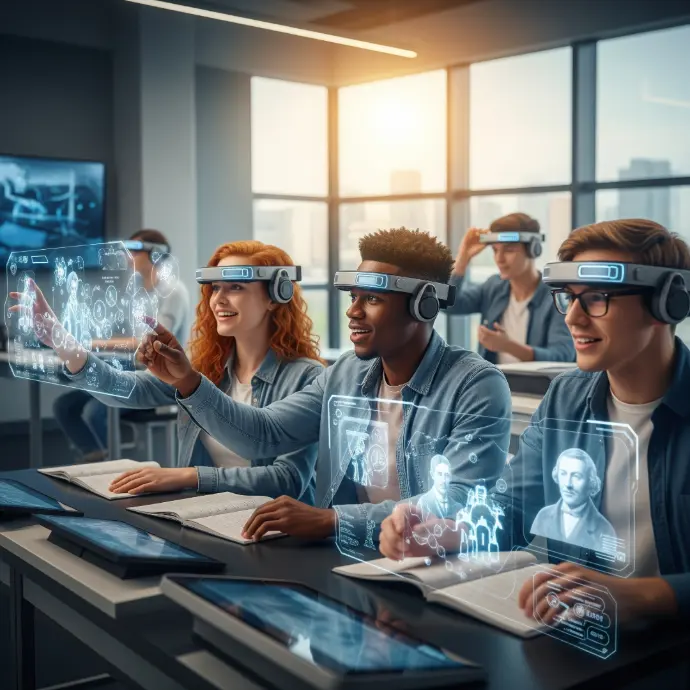Today we'll explore the exciting field of mixed reality in education, analyzing whether it could mean the end of conventional school. We'll learn how this innovative technology is changing the way we teach and learn. Get ready for an exciting adventure into the future of education.
Introduction
Mixed reality in education is the fusion of virtual reality and augmented reality, allowing students to interact with 3D environments and virtual objects in real time. This technology is used to create immersive learning experiences that overcome the limitations of traditional education.
Mixed reality in education can encompass various applications and devices that help students visualize abstract ideas, examine 3D models, and participate in interactive simulations, providing them with a deeper and more practical understanding of the subject matter.
This innovative educational tool is changing the way students acquire knowledge, giving them the opportunity to immerse themselves in virtual environments that take them to distant places, historical eras, and scientific situations, all from the comfort of their classroom or even their homes.
Mixed reality in education marks a significant advancement in the teaching-learning process. Implementing mixed reality technologies in the classroom creates a more dynamic and engaging educational environment, encouraging students to actively engage in their learning.
This innovative technological tool makes it easier for teachers to adapt the educational experience, making it appropriate for various learning styles and individual needs. Furthermore, mixed reality promotes a more practical and experiential approach to learning, which can improve knowledge retention and enhance student creativity.
By allowing students to interact with virtual objects and simulated spaces, mixed reality enriches the learning experience by offering a method based on immersion and practice, resulting in a more lasting and deeper understanding of concepts.
The inclusion of mixed reality in the learning process brings numerous important benefits for students. These advantages include increased motivation and interest, as virtual environments and interactive experiences capture students' attention and immerse them in knowledge.
Furthermore, mixed reality encourages collaborative learning by allowing students to work together in shared virtual spaces, which promotes communication, teamwork, and the exchange of ideas.
An important benefit of mixed reality in learning is that it can provide students with rapid feedback tailored to their needs. This helps them rectify errors and increase their understanding effectively and efficiently.

Mixed Reality in Education
Mixed reality, which merges virtual and augmented reality, has many useful applications in the classroom that can change the way we teach. From displaying 3D models to interacting in virtual spaces, mixed reality offers students the opportunity to engage with content in new and deeper ways, which can significantly improve their assimilation and understanding of the material.
Using mixed reality in teaching allows students to examine abstract ideas in a more concrete way, thus facilitating the understanding of difficult topics. For example, during science lessons, students could manipulate 3D models of molecules and see their behavior in real time, allowing them to better understand aspects of chemistry and biology.
Furthermore, mixed reality gives teachers the ability to personalize instruction, tailoring content to each student's individual characteristics. This is especially useful for those with different learning styles, as the technology can offer multiple ways to learn and demonstrate their understanding of the topics.
The inclusion of mixed reality in classrooms has a remarkable impact on the educational experience. By providing a more immersive way of learning, students can improve their problem-solving, critical thinking, and collaboration skills in ways that traditional teaching methods cannot. The technology encourages more active and participatory learning, which can increase students' interest and motivation to explore new topics.
Furthermore, mixed reality can eliminate geographical barriers, allowing students to access learning experiences they would not otherwise have. For example, they could take virtual tours of historical sites or participate in laboratory simulations that cannot be conducted in their area. This significantly expands learning possibilities and enriches education with immersive and valuable experiences.
Finally, mixed reality can foster creativity by encouraging students to think outside the box and find ingenious solutions to complex problems. By promoting a project-based learning approach and hands-on experimentation, the technology can prepare students to face real-world challenges in their future careers.
As mixed reality continues to develop, its influence on education will also grow. This technology is anticipated to become an essential component in the evolution of teaching, creating a more vibrant and enriching learning environment. With its ability to change the way students interact with educational material, mixed reality is an exciting innovation that can disrupt the basic principles of traditional education.
By offering more immersive, tailored, and collaborative learning experiences, mixed reality can significantly enhance the educational process and prepare students for the challenges of the future. As this technology advances, we are likely to see a radical shift in teaching and learning methodologies in classrooms around the world, cementing mixed reality as an essential foundation for innovative education.
Mixed reality is disrupting the traditional education system by providing immersive and highly interactive learning experiences. By blending components of the real environment with virtual elements, mixed reality allows students to explore abstract concepts in a concrete way, facilitating learning and memorization. This technology also offers the possibility of recreating complex environments, such as scientific experiments or tours of historical sites, that would be difficult to replicate in a conventional educational setting.
Furthermore, mixed reality promotes cooperation among students by allowing them to interact and collaborate in shared virtual environments. This helps develop social skills, teamwork, and problem-solving—essential competencies for success in today's society. By offering a more dynamic and engaging approach to learning, mixed reality encourages students to actively engage in their education, which can improve their academic performance.
Mixed reality is not only changing the way teaching and learning are done, but is also creating new opportunities for innovation in the field of education.

Challenges and Considerations
Incorporating mixed reality into the classroom presents several challenges that must be taken into account. First, the costs associated with specialized equipment and software can be expensive for many schools, limiting its availability and large-scale application. Furthermore, training and educating teachers to use this new technology effectively is a significant challenge.
On the other hand, including mixed reality in the classroom introduces pedagogical challenges. Teachers need to reconsider their teaching methods to make the most of this resource, which requires time and additional resources. Furthermore, it is critical to ensure that mixed reality is used effectively to enrich students' learning and educational experience.
It is essential to address these challenges with well-defined plans and adequate support to ensure the successful implementation of mixed reality in education.
When adding mixed reality to the school curriculum, it is vital to keep several important points in mind. First, subjects where mixed reality can add considerable educational value must be identified. This could include disciplines such as science, mathematics, history, or art education, where the three-dimensional experience and interactivity can enhance student learning.
Furthermore, it is important to create educational content and activities that make full use of mixed reality capabilities, promoting creativity, critical thinking, and problem-solving. It is also essential to ensure that the integration of mixed reality into the school curriculum is inclusive and accessible to all students, thus avoiding exclusion or inequality in access to this innovative educational tool.
Finally, it is crucial to establish clear objectives for the incorporation of mixed reality into education and to continuously evaluate its impact on the teaching-learning process so that adjustments and improvements can be made to the implementation over time.
Despite the transformative potential of mixed reality in education, its widespread adoption may encounter significant barriers. One of these challenges is the resistance to change on the part of some educators or institutions, who may view the arrival of this technology as a threat to traditional teaching methods.
Similarly, the digital divide and the lack of equitable access to devices and high-speed internet can limit the use of mixed reality in educational settings, particularly in more vulnerable or underserved communities. A significant challenge lies in the need to create and adapt curricula, educational materials, and assessment methods to effectively include mixed reality, which requires a considerable expenditure of time and resources.
Overcoming these challenges will require collaborative work among policymakers, educational institutions, the technology sector, and the educational community as a whole to ensure that mixed reality is used fairly and efficiently in education.

Impact on Society
The integration of mixed reality into education is having a notable impact on the development of students' skills. This innovative technology provides a practical and immersive method that facilitates learning in areas such as problem-solving, creativity, and teamwork. By blending real-life elements with virtual environments, mixed reality encourages critical thinking and decision-making, leading to a considerable improvement in students' cognitive abilities.
Furthermore, mixed reality offers highly personalized learning experiences, giving students the opportunity to explore concepts independently and at their own pace. This adaptability fosters a more inclusive learning environment, where each student can develop their skills according to their own needs, thus promoting more equitable development.
In this way, mixed reality not only impacts knowledge acquisition but also impacts students' overall growth, preparing them more effectively for future challenges.
The arrival of mixed reality in education suggests the possibility of significant alterations in the dynamics and organization of traditional schools. This technology challenges the traditional educational model by offering a more interactive and dynamic approach, which could lead to a reconfiguration of learning spaces.
The creation of classrooms equipped with mixed reality devices could change the physical layout of schools, promoting more flexible and adaptable learning environments. Furthermore, group work among students and interaction with educational content in a three-dimensional manner could transform how classes are taught and educational activities are carried out.
These potential changes in the dynamics and structure of traditional schools present an innovative landscape that challenges established educational practices, opening up opportunities for new teaching and learning methods that better align with current societal demands.
Although mixed reality is having a notable impact in the field of education, its incorporation does not necessarily mean the end of the traditional school. Instead, it represents an opportunity to renew and enrich the educational process by integrating innovative tools that strengthen students' skills and prepare future generations for an increasingly digital world.
The perspective on the use of mixed reality in education suggests a future in which technology becomes a valuable resource for educators, helping them enrich their teaching methods and adapt to the diverse needs of their students. This seamless integration of traditional teaching and new technologies could create a more comprehensive and varied educational environment, combining the best of both teaching methods to provide truly valuable learning experiences.
In short, mixed reality does not imply the end of traditional schooling, but rather the beginning of a new era in which innovation and technology come together to propel education toward even brighter futures.
Conclusions
Mixed reality has been presented as an innovative tool in the field of education, changing the way students acquire knowledge and teachers share information. The fusion of real-world aspects with virtual elements, using devices such as augmented reality glasses and virtual reality headsets, has created a range of possibilities in the educational field, allowing students to understand abstract ideas in a visual and practical way.
Through mixed reality, students can enter simulated environments that give them the opportunity to actively interact with concepts and situations, which aids their understanding and learning assimilation. This technology also promotes teamwork, as students have the ability to collaborate in virtual spaces, regardless of their physical location.
Furthermore, mixed reality provides new ways to personalize learning, allowing educators to tailor educational experiences to the specific needs of each student, generating immersive learning environments that adapt to diverse learning approaches.
Although mixed reality has the potential to transform teaching, it does not necessarily mean that traditional schools will disappear. Rather, this technology offers the opportunity to enrich and complement classroom teaching and learning. Face-to-face interaction, mentoring, and the development of social skills remain essential in education, and mixed reality can enhance these aspects by providing more engaging and immersive learning experiences.
It is essential to keep in mind that successful implementation of mixed reality in education requires careful planning and training for teachers. It is also crucial to address concerns related to accessibility, equity, and privacy to ensure that all students have the opportunity to benefit from this technology fairly and safely.
Mixed reality has great potential to revolutionize education by offering unique and personalized learning experiences. However, its effective integration will depend on a balanced approach that recognizes the importance of traditional teaching, even while taking advantage of the benefits that new technology can bring to the educational process.

 IHRO NEWS
IHRO NEWS